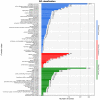Biological Characterization and Whole-Genome Analysis of Bacillus subtilis MG-1 Isolated from Mink Fecal Samples
- PMID: 38137965
- PMCID: PMC10745379
- DOI: 10.3390/microorganisms11122821
Biological Characterization and Whole-Genome Analysis of Bacillus subtilis MG-1 Isolated from Mink Fecal Samples
Abstract
Bacillus subtilis is an important part of the gut microbiota and a commonly used probiotic. In the present study, to assess the biological characteristics and probiotic properties of B. subtilis derived from mink, we isolated B. subtilis MG-1 isolate from mink fecal samples, characterized its biological characteristics, optimized the hydrolysis of casein by its crude extract, and comprehensively analyzed its potential as a probiotic in combination with whole-genome sequencing. Biological characteristics indicate that, under low-pH conditions (pH 2), B. subtilis MG-1 can still maintain a survival rate of 64.75%; under the conditions of intestinal fluid, gastric acid, and a temperature of 70 °C, the survival rate was increased by 3, 1.15 and 1.17 times compared with the control group, respectively. This shows that it can tolerate severe environments. The results of hydrolyzed casein in vitro showed that the crude bacterial extract of isolate MG-1 exhibited casein hydrolyzing activity (21.56 U/mL); the enzyme activity increased to 32.04 U/mL under optimized reaction conditions. The complete genome sequencing of B. subtilis MG-1 was performed using the PacBio third-generation sequencing platform. Gene annotation analysis results revealed that B. subtilis MG-1 was enriched in several Kyoto Encyclopedia of Genes and Genomes (KEGG) metabolic pathways, and most genes were related to Brite hierarchy pathways (1485-35.31%) and metabolism pathways (1395-33.17%). The egg-NOG annotation revealed that most genes were related to energy production and conversion (185-4.10%), amino acid transport and metabolism (288-6.38%), carbohydrate transport and metabolism (269-5.96%), transcription (294-6.52%), and cell wall/membrane/envelope biogenesis (231-5.12%). Gene Ontology (GO) annotation elucidated that most genes were related to biological processes (8230-45.62%), cellular processes (3582-19.86%), and molecular processes (6228-34.52%). Moreover, the genome of B. subtilis MG-1 was predicted to possess 77 transporter-related genes. This study demonstrates that B. subtilis MG-1 has potential for use as a probiotic, and further studies should be performed to develop it as a probiotic additive in animal feed to promote animal health.
Keywords: Bacillus subtilis; biological characteristics; mink; probiotics; whole genome.
Conflict of interest statement
The authors declare no conflict of interest.
Figures












References
-
- Boyi J.O., Hesse E., Rohner S., Saurich J., Siebert U., Gilles A., Lehnert K. Deciphering Eurasian otter (Lutra lutra L.) and seal (Phoca vitulina L.; Halichoerus grypus F.) diet: Metabarcoding tailored for fresh and saltwater fish species. Mol. Ecol. 2022;31:5089–5106. doi: 10.1111/mec.16635. - DOI - PubMed
-
- Bahl M.I., Honore A.L., Skonager S.T., Honore O.L., Clausen T., Andresen L., Hammer A.S. The microbiota of farmed mink (Neovison vison) follows a successional development and is affected by early life antibiotic exposure. Sci. Rep. 2020;10:20434. doi: 10.1038/s41598-020-77417-z. - DOI - PMC - PubMed
Grants and funding
LinkOut - more resources
Full Text Sources

